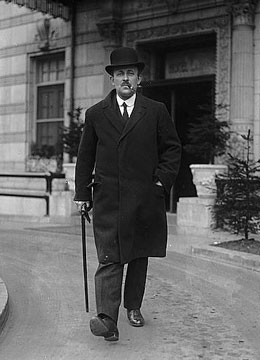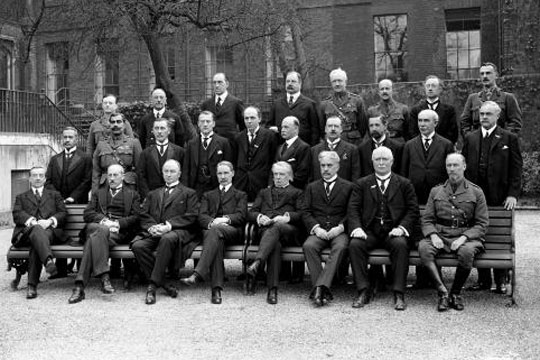Maurice Hankey (1877-1963) deserves to be far better known than he is today as the principal architect of the Cabinet Office in modern British government. It would be wrong to see the current system as identical to that established by Hankey in the early 20th century. However, there is a clear line of descent from the appointment of Hankey as the first Cabinet Secretary in 1919 to the present, both in the office and the organisation.

Hankey was an unlikely man to achieve what he did. His initial career was with the Royal Navy as an officer of the Royal Marine Artillery, although he was noted as bright and able from the beginning, quickly being given an appointment in the Naval Intelligence Department of the Admiralty. In his 20s, he became acquainted with Whitehall, where he was to spend much of his remaining career as a military officer and virtually all of the rest of his working life.
It is difficult now to appreciate the nature of British government a century ago. Cabinet meetings were still generally unrecorded; no record was kept of the gist of discussions, tasks assigned to ministers or decisions arrived at. The only rudimentary and partial record was that kept by the Prime Minister himself for use in his periodic letters to the sovereign. Even at the departmental level, many papers that would now be considered official would then be treated as private papers of the minister concerned; when he left, so too did the papers.
During the period of great domestic and international turmoil prior to the First World War, this system – if it can be called that – was only just able to cope. It was further strained by the outbreak of war in 1914. The existing stresses of politics and administration were further burdened by the conduct of military operations. Fault lines soon became evident between the “frock [coats] s” (politicians) and the “brass hats” (military leaders).
The underlying structural, leadership and personality problems at the heart of government came to a head in late 1916 when Herbert Asquith was succeeded as Prime Minister by David Lloyd George. Lloyd George was dynamic, mercurial even, and he needed the complementary talents of a supreme organiser and creative bureaucrat, the role played masterfully by Hankey. In 1908 Hankey had taken on the job that would define the rest of his career, becoming the Naval Assistant Secretary to the Committee of Imperial Defence (CID), a pioneering and innovative coordinating body. In 1912 he became Secretary of the CID, a post he retained until he retired in 1938. It was after the outbreak of war in 1914 that Hankey’s career blossomed, when he became Secretary of the War Council then, from 1916, Secretary of the War Cabinet. He brought order to key bodies, principally the War Cabinet, and now had an important role in coordinating the efforts of politicians and officials on one side, and the military chiefs on the other. This had been singularly lacking in the early conduct of the war.

In early 1917 there were huge losses of merchant shipping to German submarines. Despite considerable, if misguided, efforts there appeared no clear solution to a problem which not only limited military operations but also carried the threat of starvation to the nation. This was a problem of grand, strategic dimensions. Some junior naval officers made contact with Hankey who presented a paper based on their concerns to the Prime Minister, David Lloyd George. This led to the introduction of a convoy system for merchant shipping, after which shipping losses declined dramatically, the spectre of shortages and famine receded and greater flexibility in military operations was assured. This was an important outcome greatly facilitated by Hankey’s role, though later played down by Lloyd George. This matter demonstrated Hankey’s methods of operation, acting both as a recipient of information and opinions from a wide variety of sources, a synthesiser of information, then a conduit to the highest decision-point in the government. One might almost view him as a progenitor of the Joint Intelligence Committee.
From 1919, Hankey was able to bring order to the Cabinet itself, in his new, peacetime role as the first Cabinet Secretary. A strong Cabinet Office organisation was built up, meetings were properly recorded and decisions noted, then allocated to departments for action to be taken. During Hankey’s long tenure of office (until his retirement in 1938) this developed into the more extensive and comprehensive organisation that can still be seen today. Although it can be argued that his greatest years corresponded with the Lloyd George premiership of 1916-1922, Hankey’s flexibility and utility are evident from the fact that both he, and the Cabinet office system, were retained after later changes of government, despite attempts by others to take control of, or even abolish, it.
As well as a distinguished personal career, Hankey made a major contribution to the system of cabinet government, which can clearly be traced from his period of office to the present day. On his retirement in 1938, he continued to hold the posts of Secretary of the CID, Cabinet Secretary and Clerk to the Privy Council. No-one did more than Maurice Hankey to establish and refine the system of government that was forged in the trials of the First World War, survived the test of the Second World War and still endures in a clearly recognisable form today.
Copyright W J R Gardner. This article was produced as part of the No10 Guest Historian series, coordinated by History & Policy.
Keep tabs on the past: sign up for our email alerts